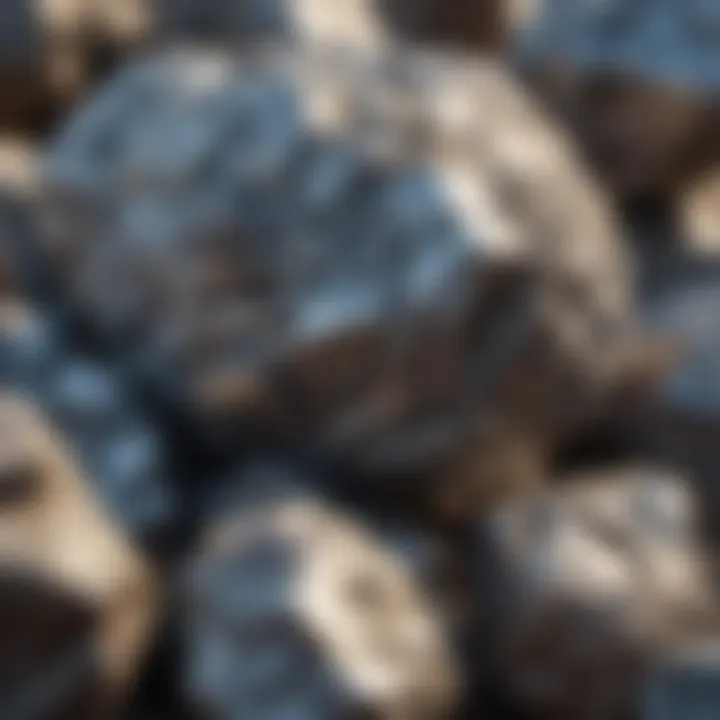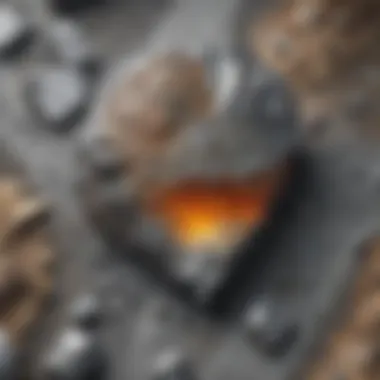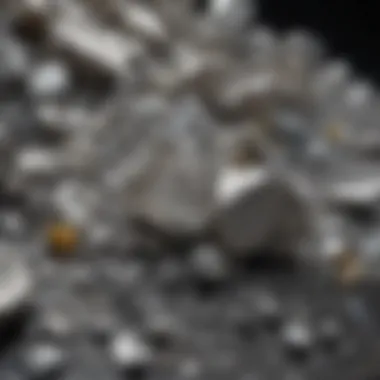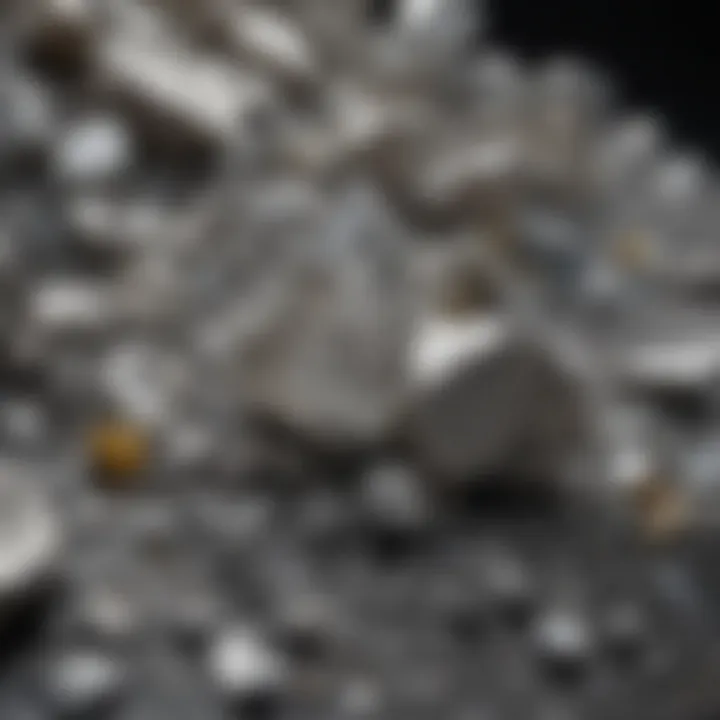Exploring the Wonders of Silver Rocks and Minerals


Intro
Silver, a metal often associated with wealth and beauty, has a complex geological history that traces back millions of years. This article will examine the unique world of silver rocks and minerals, shedding light on their formation, ecological significance, and varied applications. We will explore notable silver minerals, provide guidance for identification, and discuss the processes involved in mining and processing these valuable resources. Moreover, we will highlight the ecological implications of silver mining, focusing on the delicate balance between extraction and preservation.
History and Origins
Overview of Silver Rocks and Minerals
Silver has captivated human civilization for centuries. Its journey begins deep within the Earth’s crust, where geological processes lead to the formation of various silver-containing minerals. Over time, erosion and tectonic activity expose these minerals, bringing them closer to the surface.
Many silver minerals are created through hydrothermal processes. This involves hot fluids circulating through rock formations, gradually depositing silver as they cool. This geological activity can create rich deposits that are later mined for economic benefit.
Historical Significance and Cultural Impact
Silver’s importance extends beyond its geological properties. Throughout history, the metal has held significant value in trade, finance, and art. Ancient cultures, such as those in Mesopotamia and Egypt, used silver for currency and ornamental purposes. In Europe, silver played a crucial role in the economy from the Middle Ages to the Renaissance, influencing trade routes and wealth accumulation.
The cultural impact of silver is profound. It appears in various artifacts and artworks, symbolizing purity and value. From silver spoons to intricate jewelry, the material reflects craftsmanship and societal status.
Identification and Classification
Guide to Identifying Silver Rocks and Minerals
Identification of silver minerals can be challenging yet fascinating for collectors. Key factors to consider include:
- Color: Silver minerals can vary from metallic gray to shiny, lustrous tones.
- Luster: Many silver-containing minerals exhibit a metallic luster, crucial for identification.
- Form: Crystalline structures can vary. Look for cubic or octahedral forms.
- Hardness: This property is measured using the Mohs scale. Some silver minerals might be soft, while others can be quite hard.
By utilizing these characteristics, enthusiasts can learn to distinguish between various silver minerals. An example is Argentite, which may resemble graphite at a glance but can be identified by its silver sheen and softer texture.
Common Types and Variations
Several notable silver minerals deserve mention. These include:
- Argentite: A silver sulfide mineral often mined for its high silver content.
- Native Silver: Silver found in its elemental form, highly valued by collectors.
- Chalcocite: A copper sulfide mineral that also contains silver.
- Cerargyrite: Known for its rich color range, often found in arid mining regions.
Collecting and understanding these minerals can enrich the experience for enthusiasts. Knowing the properties and geologic settings of these minerals adds depth to the interest in silver rocks.
"Understanding the origins and applications of silver rocks not only enhances collection efforts but also deepens appreciation for Earth’s natural resources."
End
The study of silver rocks and minerals is a fascinating pursuit for anyone interested in geology or collecting. The historical significance, identification skills, and environmental considerations present a well-rounded understanding that goes beyond mere collection. Each aspect enriches the narrative of these valuable resources.
Prelude to Silver Rocks and Minerals
Silver rocks and minerals hold a unique place in both geology and industry. The study of these materials provides critical insight into the processes that shape our Earth's crust, as well as their practical applications in various fields. Silver, known for its distinctive properties, has been valued for centuries. Understanding silver's characteristics allows collectors and enthusiasts alike to appreciate its significance fully.
Through exploring silver minerals, we consider their geological formation, which encompasses tectonic processes and hydrothermal activity. This knowledge serves as a foundation for appreciating silver's role in different contexts, be it economic, cultural, or environmental.
The diversity of silver minerals, such as native silver, silver sulfides, and silver oxides, reveals the complexity of geological processes. Each type has its own set of characteristics, making identification an essential skill for collectors. Mastering these identification techniques, from visual characteristics to chemical tests, enables one to distinguish among various specimens, making the collecting experience more rewarding.
Furthermore, silver mining has played a pivotal role in both historical and contemporary economies. From ancient civilizations that revered silver to modern mining techniques, understanding this evolution is crucial. Collectors who grasp the historical context will appreciate the stories behind the specimens they collect.
Finally, the environmental impact of silver mining is a pressing concern. Understanding habitat disruption, pollution issues, and sustainability practices is essential for any responsible collector. The future of silver resources will depend not only on the extraction methods used but also on how these practices align with ecological preservation.
"A comprehensive understanding of silver’s geological and industrial significance is key to informed collecting."
The significance of silver rocks and minerals cannot be understated. They serve as a bridge connecting geological science and human culture, providing valuable insights into the Earth's processes and our own societal values.
Geological Formation of Silver
Understanding the geological formation of silver is crucial for those interested in this metal, especially for collectors and professionals in the mining industry. Silver is found in various environments, and knowing these can enhance knowledge about where to find or extract it. The formation processes contribute not only to the existence of silver but also to its quality and the possibility of finding valuable deposits.
Tectonic Processes
Tectonic activity plays a significant role in the localization of silver deposits. The continuous movement of the Earth's crust leads to the formation of various geological structures, which can create pathways for mineral solutions.
The tectonic plates shift due to basaltic activity in the mantle, resulting in faults and fractures. These features enable hydrothermal fluids, rich in minerals, to travel and deposit silver where they cool. This process highlights the importance of tectonics in creating environments conducive to silver mineralization.
Hydrothermal Activity
Hydrothermal processes are particularly important for the formation of silver minerals. As hot water rises through the Earth's crust, it can dissolve and transport various metals, including silver.
When this hydrothermal fluid encounters cooler rock or pressure changes, it can precipitate metals in concentrated veins. This type of mineralization forms what are known as epithermal deposits, commonly associated with volcanic activity. Understanding these processes enhances the collector's ability to identify potential silver-rich locations, especially near ancient volcanic regions.
Primary and Secondary Deposits
Silver is found in both primary and secondary deposits, each with different characteristics and formation history.
- Primary Deposits: These are formed directly from the geological processes discussed above. In these cases, silver is often found mixed with other ores, needing significant refinement to obtain pure silver.
- Secondary Deposits: These form as a result of weathering and erosion of primary deposits. Over time, silver can accumulate in sediments due to water movements, enriching the soils in specific areas.
The distinction between primary and secondary deposits can influence exploration strategies, as some locations may yield higher concentrations of pure silver than others. Being aware of these differences is essential for effective prospecting and mining.
Classification of Silver Minerals
The classification of silver minerals is an essential part of understanding silver's role within geology and its various applications. By categorizing these minerals, we can identify their properties, formation processes, and uses more effectively. This classification aids researchers, collectors, and industries in making informed decisions about mining, usage, and environmental impact. The three main categories of silver minerals are native silver, silver sulfides, and silver oxides. Each type offers unique characteristics and benefits that are relevant in different contexts.
Native Silver
Native silver is one of the most recognizable forms of silver. It occurs in a pure metallic state, which means it consists almost entirely of silver atoms. This mineral typically appears as a brilliant, grayish-white metallic luster. One significant aspect of native silver is its malleability, which allows it to be easily shaped into various forms.
The presence of native silver in certain geological formations can indicate rich silver deposits. When found, it often coexists with other minerals, providing insight into the conditions of its formation. For collectors, native silver is highly sought after due to its aesthetic appeal and the allure of owning a pure representation of this precious metal.
Silver Sulfides
Silver sulfides are compounds formed when silver combines with sulfur. These minerals, such as acanthite and argentite, represent a crucial category for both mining and academic studies. Silver sulfides often occur in nature as dark gray to black minerals. Their properties vary, with some forms being valuable silver sources while others are less economically viable.
The extraction of silver from sulfide ores remains a significant industry practice. Understanding the specific silver sulfide present in a deposit can inform the mining strategy and necessary processing methods. These minerals are targets for both collectors and commercial entities due to their richness in silver content.
Silver Oxides
Silver oxides form when silver reacts with oxygen. One well-known oxide is silver oxide, which appears as a black solid. These minerals are less common than both native silver and silver sulfides but play a notable role in the chemical and physical properties of silver. The presence of silver oxides often serves as an indicator of environmental conditions, especially in relation to oxidation processes within mineral assemblages.


The study of silver oxides is crucial for researchers interested in silver chemistry and environmental impact. These minerals also find applications in various fields, including electronics and photography. Thus, while they may not dominate in abundance, their significance in both theoretical and practical contexts cannot be overlooked.
"Understanding the classification of silver minerals is not just about categorization; it’s about unlocking the secrets of their formation and utility across multiple domains."
In summary, native silver, silver sulfides, and silver oxides comprise the primary classifications of silver minerals. Each classification holds distinct characteristics that contribute to the broader narrative of silver's geological significance and value in industry. For rock and fossil collectors, realizing the differences in these categories enhances their ability to appreciate the complexities of silver minerals.
Identification Techniques
Visual Characteristics
Visual inspection provides the first line of insight into identifying silver minerals. Collectors should familiarize themselves with the distinct features that typify these materials. For example, native silver often has a metallic luster and can appear as elongated wires or irregular masses. In contrast, silver sulfides may exhibit darker tones, often showing shades of gray or black. When gathering samples, note the color, texture, and crystal habit.
Some essential visual characteristics to observe include:
- Luster: Metallic or non-metallic
- Color: Ranging from shiny silver to deep black
- Crystal Form: Prismatic, cubic, or fibrous shapes
Observation of these traits can provide immediate clues about the mineral type. Then, cross-reference these observations against established identifiers for various silver minerals.
Chemical Tests
Chemical tests offer more definitive results for identifying silver minerals. These tests can involve simple reactions to determine the presence of silver ions or other relevant chemical species. One common method includes using nitric acid, which reacts with silver to produce a distinct appearance. This is a critical step if visual characteristics alone leave ambiguity.
Some practical chemical tests include:
- Nitric Acid Test: This test reveals a white precipitate indicating the presence of silver.
- Acid Extraction: Dissolving minerals in dilute acid can help differentiate between silver and other closely related minerals.
Always handle chemicals with caution, adhering to safety protocols to avoid accidents. Precise execution of chemical tests is key to achieving reliable conclusions.
Spectroscopic Methods
Spectroscopic methods offer a sophisticated approach to identifying silver minerals through their interaction with light. Techniques such as X-ray fluorescence (XRF) or Raman spectroscopy allow for precise elemental analysis without damaging the specimen. This can be particularly beneficial when dealing with valuable or fragile samples.
In using these techniques, these points are essential to consider:
- X-ray Fluorescence (XRF): This non-destructive method can determine the elemental composition of a sample quickly, providing detailed information on the contained minerals.
- Raman Spectroscopy: This technique enhances accuracy by analyzing molecular vibrations, helping distinguish between minerals sharing similar appearances.
Methodical utilization of these advanced techniques enriches the identification process, offering collectors a more profound understanding of their specimens.
Historical Context of Silver Mining
Understanding the historical context of silver mining provides key insights into its evolution and significance over time. Silver has been a coveted metal across various societies, influencing economies, wars, and cultures. Its mining and utilization are deeply intertwined with human history, reflecting changes in technological advancements, societal needs, and environmental considerations.
Ancient Civilizations
In ancient civilizations, silver was prized not only for its beauty but also for its practical attributes. Egyptians used silver for ornaments and burial artifacts. They believed silver reflected the moon’s qualities, aligning with their spiritual beliefs. The Mesopotamians, similarly, recognized silver as a medium of trade, forging its role in economic systems. In the Americas, indigenous cultures like the Incas viewed silver as a gift from the gods, incorporating it into their daily life and religious practices. Mining methods during this era were rudimentary, mostly involving manual labor for surface extraction.
The rich deposits of silver found in places like Bolivia fueled these early mining efforts. The techniques honed by these ancient cultures laid the groundwork for future generations, blending environmental interaction with human ingenuity.
The Spanish Conquest
The Spanish conquest dramatically altered the landscape of silver mining. The discovery of vast silver rich deposits in the Americas, particularly in places like Potosí and Zacatecas, transformed Spain’s economy. The Spanish crown relied heavily on silver for financing wars and expanding its empire. The use of the mita system, which forced indigenous laborers to work in mines, highlighted the exploitative nature of this period.
Silver mining in the Americas reached its peak during the 16th and 17th centuries. The so-called "Silver Rush" was characterized by an influx of European settlers and investment in mining technologies. The amalgamation process, which involved the use of mercury, significantly improved silver extraction but also posed severe health risks to workers.
Modern Mining Techniques
In contrast to the past techniques, modern mining has evolved drastically. Today’s methods employ advanced technologies and machinery, enhancing efficiency and yield. The focus has shifted towards minimizing the environmental impact through sustainable practices. Techniques such as open-pit mining and underground mining are now standardized, allowing companies to penetrate deeper deposits with precision.
Additionally, innovations like geophysical surveying and hydraulic fracturing have enabled miners to locate and extract silver with less environmental degradation. Regulatory frameworks surrounding mining have also become stricter, emphasizing the need for responsible extraction containing measures that safeguard ecosystems.
"The history of silver mining is more than just a story of extraction; it’s one of cultural significance, economic influence, and a reflection of societal values over centuries."
In summary, from ancient civilizations to modern operations, the historical context of silver mining illustrates its profound impact on society and the environment. This backdrop is critical for understanding the broader implications of silver mining today, particularly in discussions surrounding sustainability and ethics in resource extraction.
Significance of Silver in Industry
Silver holds a prominent place in various industrial applications due to its unique properties. Its conductivity, malleability, and resistance to corrosion make it an essential material across numerous fields. This section explores the significance of silver in industry, highlighting specific elements that contribute to its continued relevance.
Electrical Applications
Silver's superior electrical conductivity makes it the preferred choice for electrical applications. It is utilized in many components such as connectors, conductors, and circuit boards. In fact:
- Connectors: Silver is widely used in electrical connectors due to its ability to reduce resistance and improve performance.
- Conductors: Many high-quality wires and cables employ silver because it allows for efficient energy transfer.
- Solar Panels: In photovoltaic cells, silver plays a crucial role in enhancing the efficiency of solar energy conversion.
Moreover, the demand for more efficient electronic devices has increased the need for silver in the tech industry. Its effectiveness in improving conductivity continues to drive research into new applications.
Medical Uses
Silver has been used in medicine for centuries. Contemporary research has shown that it has antimicrobial properties, making it invaluable in healthcare. Various uses include:
- Antimicrobial Coatings: Silver nanoparticles are applied to medical devices, reducing infection risks in surgical environments.
- Wound Dressings: Silver-infused dressings are common as they expedite healing and fight bacterial infection.
- Medical Equipment: Silver is often used in a variety of medical equipment to prevent contamination.
The medical field continues to explore silver’s potential for treating infections and accelerating recovery processes, underscoring its significance.
Jewelry and Decorative Arts
Silver's aesthetic appeal has positioned it as a favorite in jewelry and decorative arts. The benefits include:
- Versatile Design: Silver can be easily shaped and polished, allowing for intricate designs that appeal to collectors.
- Value Retention: As a precious metal, silver retains intrinsic value, making investments in silver jewelry a wise choice.
- Cultural Symbolism: In many cultures, silver represents purity and wealth, which affects its desirability in artistic expressions.
Additionally, silver is often viewed as a sustainable choice in the jewelry sector as it can be alloyed with other metals to enhance strength without compromising its beauty.
Silver’s application in various industries demonstrates its multifaceted nature and enduring importance across fields.
Understanding these industry-specific applications not only enhances our appreciation of silver but also reinforces its role as a vital resource in modern society.
Mining Processes and Techniques
Mining processes are integral to the study and utilization of silver rocks and minerals. Understanding how these processes work will provide insight into the economic importance of silver, its availability, and the environmental consequences of extraction. The methods used in the mining industry not only affect the yield of silver but also dictate the efficiency, safety, and sustainability of operations within the field. This section will cover the essential elements of prospecting and exploration, extraction methods, and the processing and refinement of silver.
Prospecting and Exploration
Prospecting is the initial phase of mining, focusing on the search for valuable minerals. It involves geological surveys, sampling, and the use of various methods to assess the potential of a site for silver mining. Geologists and miners use techniques like aerial surveys and geological mapping to identify areas with high silver concentrations. These activities require a keen understanding of geology and mineralization patterns.


The prospecting stage is critical as it determines the feasibility of mining a particular area. Tools such as geochemical analysis and geophysical techniques enhance the reliability of discovering silver deposits. A thorough prospecting phase minimizes investment risk, which can be substantial in the mining industry.
Extraction Methods
Once a promising site is identified, extraction methods come into play. Various techniques exist, including underground mining, open-pit mining, and heap leaching. Each method has distinct advantages and drawbacks, affecting both efficiency and environmental impact.
- Underground Mining: This method is often used for deep silver deposits. It involves creating shafts and tunnels to access ore. Although it requires significant initial investment, it can yield high-quality silver.
- Open-Pit Mining: Effective for shallow deposits, this method allows for large-scale excavation. It is less costly but can lead to significant landscape alteration and ecological disruption.
- Heap Leaching: This method involves piling ore and applying a leaching solution to extract silver over time. It is cost-effective for low-grade ores but raises concerns about chemical runoff.
Selecting the appropriate extraction method depends on various factors, including ore depth, grade, environmental regulations, and cost considerations. Each choice impacts the success and sustainability of the mining operation.
Processing and Refinement
After extraction, silver must undergo processing and refinement to achieve market-ready standards. This stage involves crushing, grinding, concentration, and smelting or refining.
In the first step, extracted ore is reduced in size through crushing and grinding. The goal is to liberate silver from other minerals, allowing for efficient extraction. Concentration methods, such as flotation or cyanidation, follow to separate silver from other metals.
Smelting is the next phase, where concentrated ore is heated to extract pure silver. This process often uses multiple stages to eliminate impurities and achieve the desired quality. Finally, refining methods such as electrolysis convert the silver to a high-purity form for industrial or consumer use.
The processing stage is crucial as it ensures that the silver produced meets industry standards, directly impacting both the market value and usability of the product.
"Understanding mining processes is essential for meeting both economic demands and ecological responsibilities. Proper mining practices can foster sustainability while maximizing resource utilization."
In summary, the mining processes and techniques are critical components in exploring and utilizing silver rocks and minerals. From successfully identifying and extracting deposits to refining the end product, each step plays a vital role in the overall viability of silver as a resource, making the comprehension of these processes essential for enthusiasts and professionals alike.
Environmental Impact of Silver Mining
The extraction of silver often has significant environmental consequences that cannot be overlooked. Understanding these impacts is crucial for both collectors and industry professionals. The balance between mining for silver and preserving our ecosystem is delicate. As demand for silver increases, it's important to consider the specific elements at play. This section explores habitat disruption, pollution concerns, and sustainable practices in silver mining.
Habitat Disruption
Habitat disruption is one primary concern linked with silver mining. When mining operations commence, they typically obliterate vast tracts of land. This removal affects flora and fauna, causing biodiversity loss. Animals may find their homes destroyed and face increased competition in surrounding areas. Additionally, the landscape undergoes drastic changes, which could have lasting effects on local ecosystems.
Those who collect silver minerals should be aware of these impacts. Some species may become endangered or even extinct due to this disruption. It raises ethical questions about the responsibility of collectors towards the environment.
Pollution Concerns
Pollution generated from mining activities poses another major challenge. The process of extracting silver can release harmful substances into the air and waterways. Chemicals such as cyanide and heavy metals can leach into nearby streams and rivers, potentially contaminating drinking water sources. This pollution can affect not only wildlife but also human populations living close to mining areas.
Air pollution is also a concern. Dust generated from mining activities can contain silica and other particles, which might contribute to respiratory problems in nearby communities. People working in mines are also at risk, exposing them to hazardous conditions. It is vital to consider these drawbacks when evaluating the benefits of silver mining.
Sustainability Practices
In response to the environmental impacts, the silver mining industry has begun incorporating sustainability practices. Some operations are adopting techniques aimed at reducing their ecological footprint. These might include methods like:
- Reclamation: Restoring land after mining concludes to regain its previous state.
- Reducing waste: Implementing practices that minimize byproduct creation.
- Water conservation: Employing systems that recycle water used in mining operations.
"Implementing sustainable practices not only helps mitigate the environmental impacts but can also improve the long-term viability of mining operations."
Fostering a responsible approach to silver mining is crucial for future generations. Collectors and enthusiasts can promote sustainable practices by supporting companies that prioritize environmental stewardship.
Understanding the environmental impact of silver mining provides perspective on its complex implications, urging more conscientious actions within the industry and among collectors.
Cultural Significance of Silver
In exploring silver and its minerals, it is essential to understand the cultural significance they hold. Silver has been embedded in the fabric of many societies for centuries. Its uses are not just practical; they reflect deep-seated beliefs, values, and traditions. The unique characteristics of silver, such as its luster and malleability, have made it a preferred material in various cultural expressions.
Symbolism in Various Cultures
Throughout history, silver has symbolized purity, wealth, and the moon across various cultures. In many ancient civilizations, silver was associated with the lunar deity due to its bright reflective quality. In Egyptian culture, silver often represented divine qualities, standing in stark contrast to the more commonplace copper. The value of silver extended beyond its physical attributes; it served as a medium for trade and a marker of social status. In modern contexts, gifting silver items is often regarded as a symbol of love and commitment, seen in traditions such as weddings and anniversaries.
"Silver has always been regarded as a bridge between the earthly and the divine, offering a way to connect with profound human experiences."
Artistic Representations
The aesthetic appeal of silver has led to its frequent use in art and decoration. Various cultures have created intricate designs in silver, ranging from jewelry to decorative arts. Indigenous peoples, for example, have created stunning works that reflect their beliefs and stories. These objects are not only beautiful; they often carry historical narratives and serve as cultural artifacts. Silverwork can be seen in ceremonial items, reflecting the craftsmanship and significance of materials in rituals.
In contemporary art, silver continues to inspire creativity. Artists use silver in mixed media works, reflecting its enduring appeal and versatility. Its reflective nature also adds depth and dimension to artworks, inviting viewers to engage with the piece on multiple levels.
In summary, silver's cultural significance extends far beyond its material value. From its spiritual symbolism to its artistic uses, silver plays a vital role in human expression. Understanding this significance enriches our appreciation of silver minerals and highlights their place within human history.
Collecting Silver Minerals
Collecting silver minerals is an endeavor that captivates enthusiasts and researchers alike. Knowledge of silver specimens fosters appreciation and can yield valuable insights into geological processes. Importantly, it provides an opportunity to connect with nature through firsthand exploration of mineral deposits. This section highlights elements that are vital for effective and rewarding collecting experiences.
Identifying Quality Specimens
Identifying quality specimens of silver minerals is crucial for collectors aiming to enhance their collections. A good specimen should exhibit clarity, luster, and distinct characteristics that make it stand out. Some indicators of quality include:
- Purity: Higher concentration of silver enhances its desirability and value.
- Form: Crystalline forms or well-defined shapes are often sought after.
- Luster: A bright, metallic shine indicates a quality specimen.
- Inclusions: Unique features can enhance the aesthetic appeal.
To effectively identify these qualities, collectors often rely on visual inspection and knowledge of specific silver minerals, such as cerargyrite and argentite. Keeping reference samples can also aid in comparison.
Preservation Methods
Preserving collected specimens is vital to prevent deterioration over time. Several methods help maintain the integrity of silver minerals:
- Dry Storage: Keeping specimens in a dry environment reduces oxidation.
- Controlled Temperature: Avoid exposure to extreme temperatures.
- Use of Protective Cases: Display cases can prevent physical damage and environmental exposure.
Regular inspection of the specimens is also necessary. If signs of tarnish or degradation appear, appropriate cleaning methods must be applied cautiously. Understanding the specific mineral composition is essential for choosing suitable cleaning techniques.
Market Considerations
The market for silver minerals has its unique dynamics, influenced by various factors. Collectors should consider:
- Market Demand: The interest in specific specimens can fluctuate based on trends and collector preferences.
- Rarity: Rare specimens command higher prices, often making them an attractive investment.
- Condition: The physical state of the specimen regarding preservation and damage significantly impacts market value.
Additionally, collectors can engage in community discussions on platforms such as Reddit and Facebook to better understand market trends and seek advice from experienced collectors.
Key Takeaway: Collecting silver minerals is not merely a hobby but a profound engagement with the earth's history. By identifying quality specimens, employing preservation methods, and staying informed about market dynamics, collectors can enhance their experience and investment in silver minerals.
Role of Silver in Modern Economy


Silver plays a crucial role in the modern economy across various sectors. Its unique properties and versatility make it invaluable in both traditional and emerging industries. Understanding its economic significance provides insight into trends and dynamics shaping markets today.
Market Dynamics
The silver market operates under conditions influenced by many factors. Supply and demand dynamics are central to its valuation. The production of silver often occurs as a byproduct of mining for other metals, notably gold and copper. This can lead to fluctuations in availability based on the focus of other mineral extraction efforts.
Furthermore, silver has industrial applications that significantly impact its market. Industries such as electronics and solar energy heavily rely on silver. As technological advancements continue to grow, the demand for silver in electronics, specifically in conductive inks and terminals, may rise sharply. Additionally, the surge in renewable energy, particularly in solar panel production, positions silver as a commodity with high future demand.
For collectors, understanding these market dynamics is vital. Collectors must keep track of prices and economic indicators that can influence values of silver collectibles, such as historical coins or natural mineral specimens.
"The fluctuations in silver prices can reveal shifts in global economic conditions. Collectors should pay attention to these trends to maximize their investments."
Investment Trends
Investing in silver is gaining traction among investors as a hedge against inflation and economic downturns. Investors regard silver as a more affordable option than gold, often leading to increased buying activity during uncertain times. This relationship creates a unique investment trend where silver operates both as a commodity and a form of currency.
Moreover, the integration of silver into financial instruments, such as ETFs (Exchange-Traded Funds) and futures contracts, enhances its attractiveness. Such financial vehicles allow investors to gain exposure to silver without the challenges of holding physical bullion or coins.
As the market exits from traditional stocks and bonds, silver garners attention. Collectors and investors alike are initiating purchases, not just for aesthetic enjoyment but as long-term financial strategies. The varying accessibility of silver makes it appealing to a broad range of investors, cementing its place within modern economic frameworks.
Future of Silver Resources
The future of silver resources is a critical topic for understanding both the longevity of this precious metal in industry and ecological stability. As silver possesses unique properties that make it valuable in various sectors, such as electronics, medicine, and renewable energy, it is imperative to evaluate how these resources can be maintained sustainably. Concerns are rising regarding diminishing silver reserves and the consequences of traditional mining practices on both the environment and local communities.
In this section, we will explore renewable mining practices and consider global demand predictions, each shaping the outlook of silver resources for industries and collectors alike.
Renewable Mining Practices
Renewable mining practices refer to methods that minimize ecological impact while optimizing resource extraction. These practices consider natural resource sustainability and address the ecological footprint typically associated with mining processes. Techniques such as responsible sourcing of silver, using advanced technologies, and recycling silver from electronic waste are vital components.
Key aspects of renewable mining practices include:
- Sustainable practices: Implementing strategies that reduce habitat disruption, such as selective mining methods, helps in preserving the surrounding ecosystem.
- Reduction of pollution: Utilizing eco-friendly solvents and less detrimental waste management systems lowers the risk of water and soil contamination.
- Community engagement: Involving local communities in decision-making processes fosters transparency and encourages socially responsible mining.
These renewable practices seem especially important as the demand for ethical sourcing continues to rise, influencing collectors’ choices and potentially shifting the market.
Global Demand Predictions
The global demand for silver holds significant implications for its future as a resource. Different sectors like electronics, batteries, and renewable energy technology are rapidly evolving. For instance, the growth in solar panel installations boosts the need for silver due to its high conductivity. Analysts project that demand for silver will continuously increase in the coming years.
Several factors influencing demand include:
- Technological advancements: As industries explore innovative applications for silver, ranging from 5G technology to medical devices, the demand landscape is changing.
- Investment trends: Investors often turn to silver as a safe haven during economic uncertainty, impacting prices and availability in the market.
- Global initiatives: The push for renewable energy sources may increase silver consumption, especially in solar technologies, as countries implement greener policies.
"Silver is not just a precious metal but a critical element in our transition to a more sustainable future."
Scientific Research on Silver
Scientific inquiry into silver extends beyond mere geological interest and mining practices; it encompasses a vast array of applications, particularly in nanotechnology and biomedical fields. These aspects highlight silver's versatility and uniqueness as a natural resource. Understanding the contemporary research trends offers a glimpse into the future potential of silver.
The significance of this scientific research lies in its potential to drive advancements in technology and healthcare. Researchers aim to harness silver's properties, such as its conductivity and antibacterial effects, to fabricate new materials and medicines that may revolutionize various industries. These findings not only reflect the value of silver but also underscore the need for continuous exploration of its multifaceted applications.
Nanotechnology Applications
Nanotechnology represents a burgeoning field that takes advantage of materials at the nanoscale, precisely where silver demonstrates remarkable properties. Silver nanoparticles exhibit exceptional electrical conductivity, thermal conductivity, and high surface area, making them suitable for a range of applications.
In electronics, silver nanoparticles can enhance the performance of devices such as sensors and conductive inks. Their ability to create more efficient energy devices is also being studied. For example, silver is used in solar cells to improve light absorption, translating to more effective energy conversion.
Moreover, the antibacterial properties of silver nanoparticles are drawing attention in the medical domain. These particles can be integrated into coatings for surgical instruments, wound dressings, and various medical devices to minimize infection rates.
Some researchers even explore using silver nanoparticles in drug delivery systems, where they can target specific cells more effectively than standard methods, thus improving therapeutic outcomes.
Biomedical Research
The biomedical potential of silver is considerable, primarily because of its antimicrobial characteristics. Studies have shown that silver is effective against a wide range of pathogens, including bacteria, fungi, and viruses. This capacity to combat infections has positioned silver as a prominent element in medical research, particularly in wound care and surgical procedures.
Current investigations include developing silver-infused products that facilitate quicker wound healing and reduce microbial colonization. For instance, silver sulfadiazine is a commonly used cream for preventing and treating infections in burn areas.
Beyond topical applications, research is also delving into silver's effectiveness in coatings for medical implants, such as stents and hip replacements. These devices can benefit from silver's antimicrobial properties, potentially decreasing the incidence of post-operative infections.
"Silver nanoparticles have undeniable potential in modern healthcare, especially in infection control and targeted therapies."
Case Studies of Notable Silver Mines
Case studies of notable silver mines provide a lens through which we can understand the complexities of silver extraction and its impact on societies and economies. These case studies reveal the historical significance of silver mining and its technological developments over time. They also highlight the geographical locations, challenges, and benefits associated with major silver deposits. Notably, these mines illuminate the relationship between geology and the socio-economic fabric of the areas where they are situated. Furthermore, they act as important examples for both collectors and other gologists seeking insight into mining practices and mineral formation.
The Potosí Mine
The Potosí Mine, located in Bolivia, is one of the most infamous silver mines in history. Discovered in the 1540s, it quickly became a cornerstone of the Spanish Empire's wealth. The mine is situated high in the Andes Mountains, which posed various extraction challenges but also offered rich deposits of silver ore. The mineral wealth derived from the Potosí Mine was so abundant that it drastically shifted economic power towards Spain during the colonial period.
Workers at the Potosí Mine faced extreme conditions, including hazardous working environments and high-altitude challenges. The extraction methods used, which included the labor-intensive technique known as ‘patio process’, were innovative for their time but often exploited local laborers. This exploitation and the environmental impact of mining operations are key points of discussion in understanding the legacy of the mine.
Economically, the Potosí Mine exemplifies how localized mineral wealth can lead to widespread societal changes. It contributed to the creation of a trade network connecting Europe, Africa, and the Americas, significantly altering global trade patterns. Today, while the mine is no longer a significant silver producer, its history continues to attract researchers and rock collectors interested in ethical mining and historical geology.
The Comstock Lode
The Comstock Lode, located in Nevada, is another monumental site in the context of silver mining. Discovered in 1859, it marked the first major discovery of silver in the United States and ignited a silver rush that transformed the region. The Comstock Lode was unique because it contained rich deposits of not just silver but also gold, leading to diverse mining approaches and an evolving economic landscape.
The mining techniques developed at the Comstock Lode showcased innovative practices, such as the use of hydraulics and elaborate underground systems. These methods catered to the need for efficient extraction in increasingly deeper mines. As a result, the Comstock became a model for subsequent mining operations in the United States.
However, the Comstock Lode also faced its challenges. Economic fluctuations and environmental concerns often led to a boom and bust cycle for the region. The eventual decline of silver prices caused many mines to shut down, impacting local economies significantly. For collectors and researchers today, the Comstock Lode offers a rich historical repository of mining technology and societal impact, making it an essential subject in the integrated study of geology and economic history.
Closure
The conclusion serves a pivotal role in synthesizing the information presented throughout the article. It serves not just as a summary but as a vantage point for understanding the multifaceted aspects of silver rocks and minerals.
Summary of Key Findings
Throughout the article, key findings highlight various critical dimensions surrounding silver rocks and minerals:
- Geological Formation: The processes involved in the formation of silver involve tectonic movements and hydrothermal activities, leading to the development of both primary and secondary deposits.
- Classification: Silver minerals are diverse, ranging from native silver to various sulfide and oxide forms, each with unique properties and characteristics.
- Mining Impact: The historical perspective shows how ancient civilizations valued silver, and modern mining techniques, while efficient, also bring environmental challenges that must be managed.
- Economic Significance: Silver plays an essential role in several applications, including electronics and medicine, making its sustainable management crucial for future industry growth.
- Research Directions: Current research focuses on innovative uses of silver in nanotechnology and biomedical fields, outlining its transformative potential moving forward.
This summary encapsulates the breadth of information provided, catering specifically to those with a keen interest in silver minerals, its historical trajectories, and applications.
The Path Forward
Going forward, it becomes essential for stakeholders involved in the silver mining and collection sectors to adopt practices that emphasize sustainability and ecological preservation.
- Adopting Sustainable Practices: The promotion of renewable mining practices is vital. By employing eco-friendly techniques, we can mitigate the environmental impacts while still meeting global demands for silver.
- Predictions of Global Demand: With advancing technologies and an increasing reliance on silver across industries, the demand is set to rise. Understanding market dynamics becomes pivotal to balancing supply with conservation efforts.
- Continuous Research: Ongoing scientific research is encouraged to explore further applications of silver. Innovations in areas like nanotechnology could revolutionize how silver is utilized, expanding its applications beyond traditional uses.



